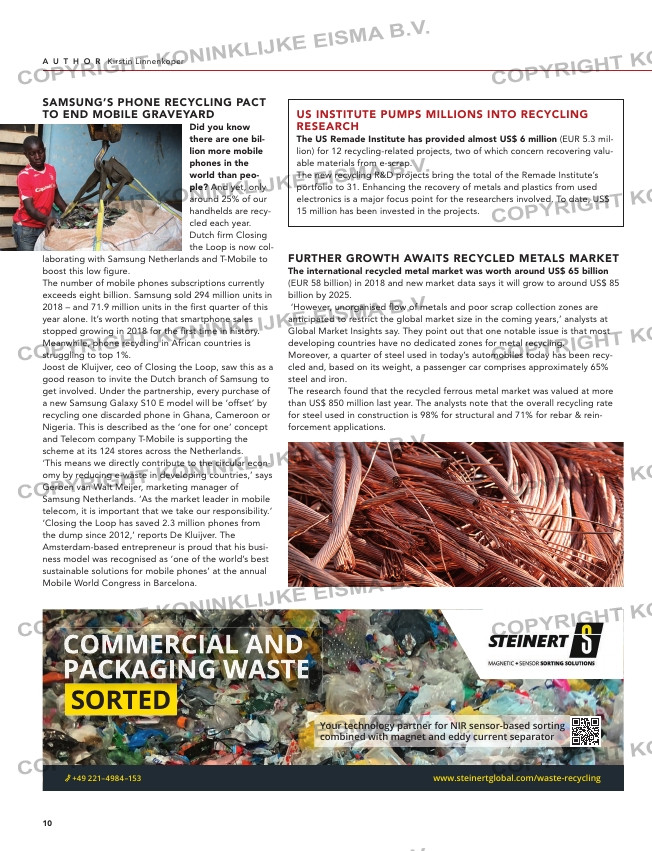Page 10 from: West Coast report + Plastics Special

10
FURTHER GROWTH AWAITS RECYCLED METALS MARKET
The international recycled metal market was worth around US$ 65 billion
(EUR 58 billion) in 2018 and new market data says it will grow to around US$ 85
billion by 2025.
‘However, unorganised flow of metals and poor scrap collection zones are
anticipated to restrict the global market size in the coming years,’ analysts at
Global Market Insights say. They point out that one notable issue is that most
developing countries have no dedicated zones for metal recycling.
Moreover, a quarter of steel used in today’s automobiles today has been recy-
cled and, based on its weight, a passenger car comprises approximately 65%
steel and iron.
The research found that the recycled ferrous metal market was valued at more
than US$ 850 million last year. The analysts note that the overall recycling rate
for steel used in construction is 98% for structural and 71% for rebar & rein-
forcement applications.
SAMSUNG’S PHONE RECYCLING PACT
TO END MOBILE GRAVEYARD
Did you know
there are one bil-
lion more mobile
phones in the
world than peo-
ple? And yet, only
around 25% of our
handhelds are recy-
cled each year.
Dutch firm Closing
the Loop is now col-
laborating with Samsung Netherlands and T-Mobile to
boost this low figure.
The number of mobile phones subscriptions currently
exceeds eight billion. Samsung sold 294 million units in
2018 – and 71.9 million units in the first quarter of this
year alone. It’s worth noting that smartphone sales
stopped growing in 2018 for the first time in history.
Meanwhile, phone recycling in African countries is
struggling to top 1%.
Joost de Kluijver, ceo of Closing the Loop, saw this as a
good reason to invite the Dutch branch of Samsung to
get involved. Under the partnership, every purchase of
a new Samsung Galaxy S10 E model will be ‘offset’ by
recycling one discarded phone in Ghana, Cameroon or
Nigeria. This is described as the ‘one for one’ concept
and Telecom company T-Mobile is supporting the
scheme at its 124 stores across the Netherlands.
‘This means we directly contribute to the circular econ-
omy by reducing e-waste in developing countries,’ says
Gerben van Walt Meijer, marketing manager of
Samsung Netherlands. ‘As the market leader in mobile
telecom, it is important that we take our responsibility.’
‘Closing the Loop has saved 2.3 million phones from
the dump since 2012,’ reports De Kluijver. The
Amsterdam-based entrepreneur is proud that his busi-
ness model was recognised as ‘one of the world’s best
sustainable solutions for mobile phones’ at the annual
Mobile World Congress in Barcelona.
METAL PIRATES SELL WWII ‘GHOST SHIPS’
TO THE HIGHEST BIDDER
There were thousands of pirates looting ships in the
Caribbean during the Golden Age. Recently, scrapyards have
seen a surge in unusual metals turning up on-site. It turns out,
pirates are not yet extinct.
Bronze propellers and steel plates from World War II aircraft
and vessels are worth upwards of US$ 5000 a piece. An entire
wreck is valued at least a million dollars. It’s interesting to note
that around 120 000 ships were manufactured in the years lead-
ing up to WWII.
The metal piracy trend made global headlines in 2016, when
various sunken warships and submarines disappeared from their
watery graves in the Java Sea. Naval reseachers found out the
vessels ‘went missing’ with the help of a sonar 3D map.
‘In recent years it’s not the treasure that’s making people go
look for wrecks, it’s the metal,’ says Kim Browne of Charles
Sturt University in Australia. She published a study on ‘ghost
battleships’ in the Journal of Maritime Archaeology. ‘The metal
and bronze and all the casings of the electrical components of
the ship bring in large amounts of money,’ the lecturer con-
firms.
Salvaging the parts is no easy job considering the operation
takes place in the deep – sometimes at 70 metres (230 feet)
underwater. It’s likely these illegal scrapping activities take
months, maybe even years to complete. ‘The illicit removal of
the wrecks illustrates the jurisdictional difficulties maritime pow-
ers face in preventing unauthorised interference with their
sunken military property,’ Browne notes.
A famous example of a looted vessel is Australia’s light cruiser
HMAS Perth – it serves as a ‘war grave’ to 353 sailors.
Archaeologists claim only 40% of the vessel remains intact due
to ‘heavy plundering’.
US INSTITUTE PUMPS MILLIONS INTO RECYCLING
RESEARCH
The US Remade Institute has provided almost US$ 6 million (EUR 5.3 mil-
lion) for 12 recycling-related projects, two of which concern recovering valu-
able materials from e-scrap.
The new recycling R&D projects bring the total of the Remade Institute’s
portfolio to 31. Enhancing the recovery of metals and plastics from used
electronics is a major focus point for the researchers involved. To date, US$
15 million has been invested in the projects.
A U T H O R Kirstin Linnenkoper
+49 221–4984–153 www.steinertglobal.com/waste-recycling
Your technology partner for NIR sensor-based sorting
combined with magnet and eddy current separator
SORTED
COMMERCIAL AND
PACKAGING WASTE
08-09-10-11-12-13_trendsenupdates.indd 10 08-08-19 11:01



